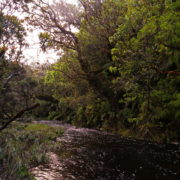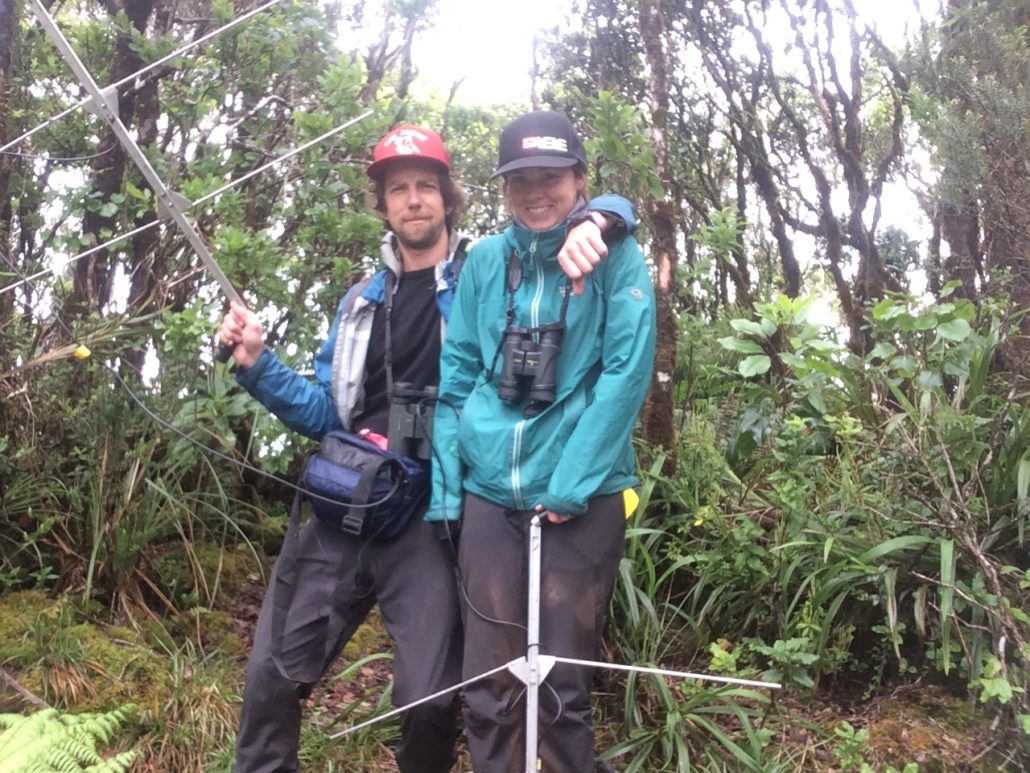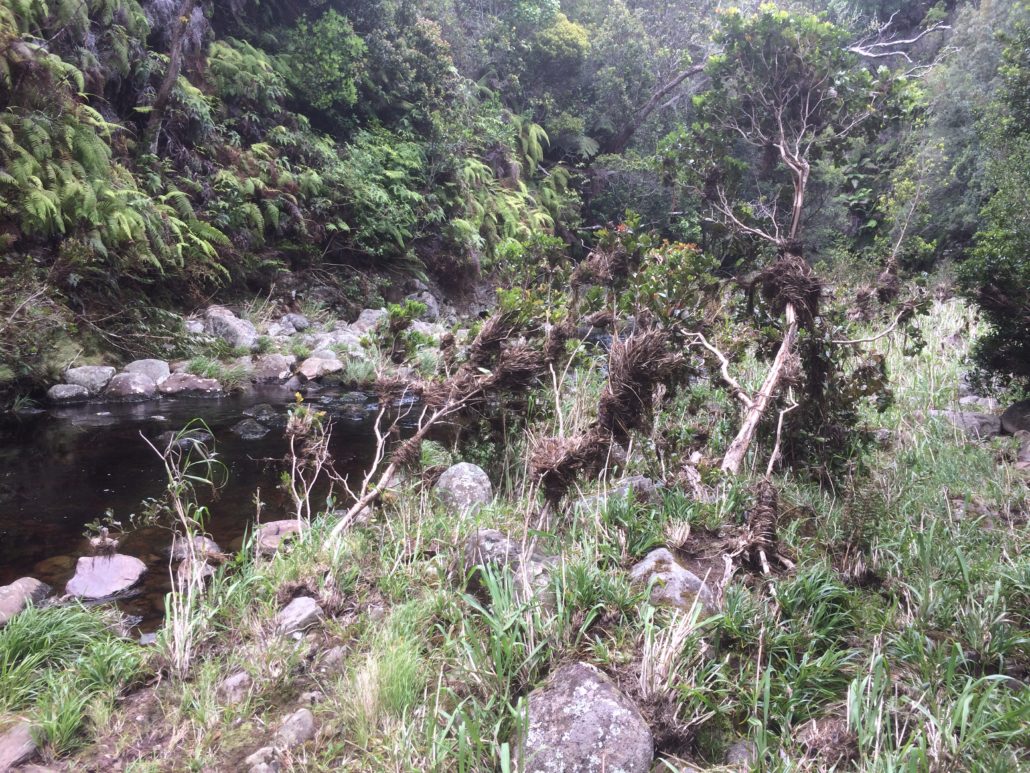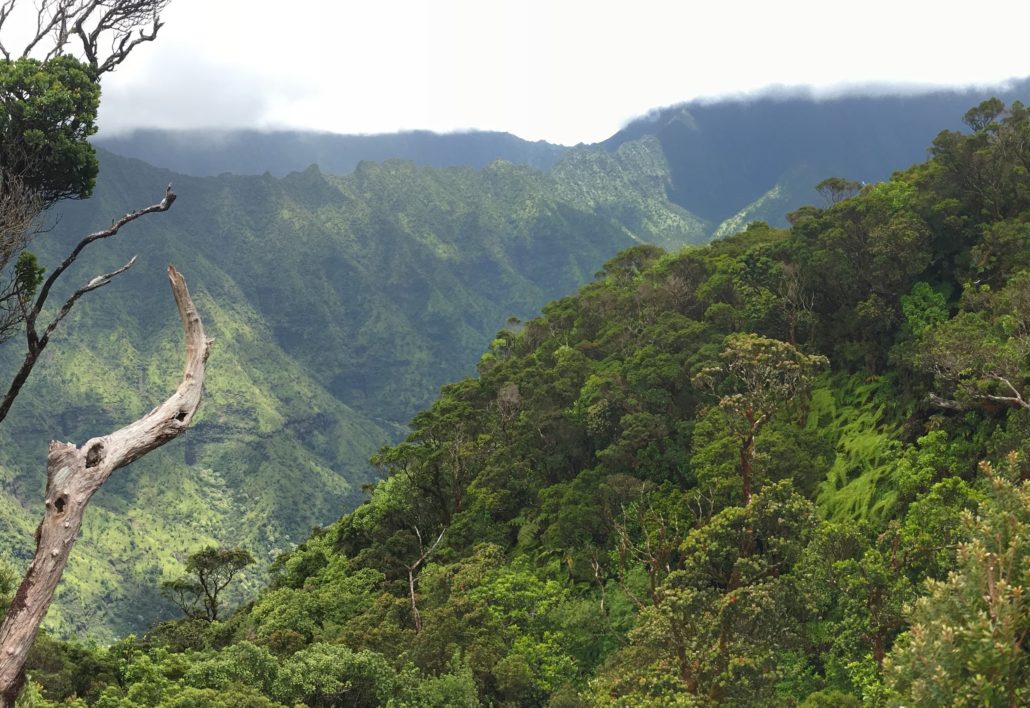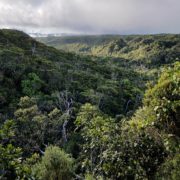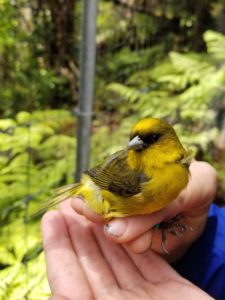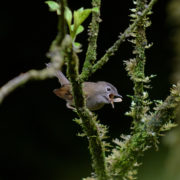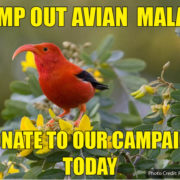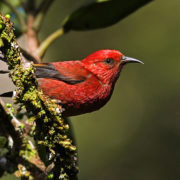Fifty-six waterfalls and counting! All teeming with water as I looked west in disbelief at the scene that lay in front of me. A few minutes later the view was masked by fog once again, the rain continued, so I walked up to camp and sunk back into my sleeping bag. Little did I know at the time that parts of Kaua’i were experiencing some of the most intense rainfall ever recorded in 24- and 48-hour periods. No small feat for an area that is often regarded as one of the wettest on Earth!
And here I was watching birds.
The previous week I had been flagging point count transects, collecting forest bird point count data in Koke’e State Park, and helping with outreach at a garden festival. And now I found myself in a remote section of the Alaka’i Swamp, up high on a plateau overlooking some of the greatest views the United States, and some might say the world, has to offer. It didn’t seem to matter that it was raining. I could still hear ‘Apapane, ‘Anianiau, and ‘Elepaio calling and flying around camp and there was plenty of food to have fun throwing together and cooking up as ‘mystery meals’.
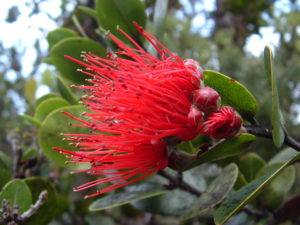 My time in the Alaka’i had me watching family groups of the critically endangered ‘Akikiki within a stone’s throw as they called and clambered around ‘Ohi’a Lehua trees like more curious nuthatch relatives, grasping at small branches from all angles and investigating for food. Incredibly energetic birds that are always on the move, they were so interesting to watch and ponder what they were thinking. On one occasion I spent half a day helping with the setup and take down of a large ladder for retrieving eggs from an ‘Akeke’e nest to add to the growing aviary population on one of the larger Hawaiian islands. Both the ‘Akikiki and ‘Akeke’e have a very real chance of going extinct in the wild within the next few years if current trends continue. To steal a phrase from a good friend from Kaua’i, “this pulls at my heart strings”. For an island that has already experienced so much avian loss, it is hard to believe that there is more still looming.
My time in the Alaka’i had me watching family groups of the critically endangered ‘Akikiki within a stone’s throw as they called and clambered around ‘Ohi’a Lehua trees like more curious nuthatch relatives, grasping at small branches from all angles and investigating for food. Incredibly energetic birds that are always on the move, they were so interesting to watch and ponder what they were thinking. On one occasion I spent half a day helping with the setup and take down of a large ladder for retrieving eggs from an ‘Akeke’e nest to add to the growing aviary population on one of the larger Hawaiian islands. Both the ‘Akikiki and ‘Akeke’e have a very real chance of going extinct in the wild within the next few years if current trends continue. To steal a phrase from a good friend from Kaua’i, “this pulls at my heart strings”. For an island that has already experienced so much avian loss, it is hard to believe that there is more still looming.
Honestly, I knew there was only so much I was going to accomplish in three weeks. I certainly wasn’t going to save a species from extinction. But knowledge and experience can and should be passed on. I love chatting random people up that seem interested so I made it a point to learn as much as I could in my short visit and I’m already sitting down with friends and colleagues and teaching them about the plight of Hawai’i’s, and specifically Kaua’i’s, birds.
The individuals I worked with and alongside on the Kaua’i Forest Bird Recovery Project were highly committed, professional, and extremely efficient at working and living in the sometimes cold, and usually wet, forests, and really knew the native birds of Kaua’i well. They all knew their roles and most importantly, they all wanted to be there, in the woods, living and learning with their colleagues. Honestly. I thought they were all fantastic. On behalf of the birds and everything else that depends on them in the forests of Kaua’i, please continue your great work. You really are the keepers of the forest and these creatures truly do depend on the time and effort you sacrifice out of your lives.
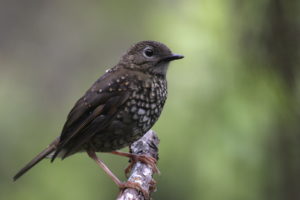 Some of my most memorable moments came in the discovery of a wicked looking fungus, finally hearing a Puaiohi singing (it’s a solitaire!), cooking with colleagues, getting up first and delivering that first cup of coffee to my friend in the morning, climbing to the top of the ‘Akeke’e nest ladder (I’m not good with heights!), seeing Kauai from the view of a helicopter pilot, and honestly, just sharing the love of the outdoors and the work with colleagues.
Some of my most memorable moments came in the discovery of a wicked looking fungus, finally hearing a Puaiohi singing (it’s a solitaire!), cooking with colleagues, getting up first and delivering that first cup of coffee to my friend in the morning, climbing to the top of the ‘Akeke’e nest ladder (I’m not good with heights!), seeing Kauai from the view of a helicopter pilot, and honestly, just sharing the love of the outdoors and the work with colleagues.
On my first week in Kauai I spent a good deal of time with two other biologists from the Big Island and Oahu and I would be remiss not to thank Seth and Jason for the friendship and experience they passed on during our short stint together.
I want to give a special shout out to my new friend who made the experience so much more memorable. You know who you are. Experiencing the dawn to dusk slog through mud and rain with this individual was a treat and I will forever be reminded of them when thinking of Kauai.
Will I be back? You bet!
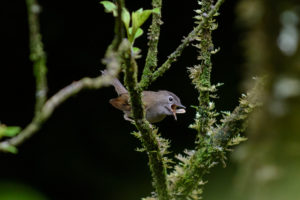 The Puaiohi is a critically endangered native thrush and the last of the island’s native seed-dispersing species. As such, the Puaiohi, which numbers only 500 birds in the wild, is central to maintaining healthy native forests. Given the Puaiohi’s critical ecosystem role, small population size and restricted range, gaining a better understanding of the conditions which affect its reproduction and survival is critical.
The Puaiohi is a critically endangered native thrush and the last of the island’s native seed-dispersing species. As such, the Puaiohi, which numbers only 500 birds in the wild, is central to maintaining healthy native forests. Given the Puaiohi’s critical ecosystem role, small population size and restricted range, gaining a better understanding of the conditions which affect its reproduction and survival is critical. 
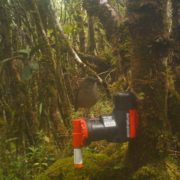
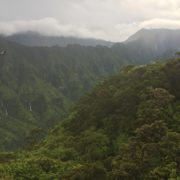 Liz Abraham
Liz Abraham


